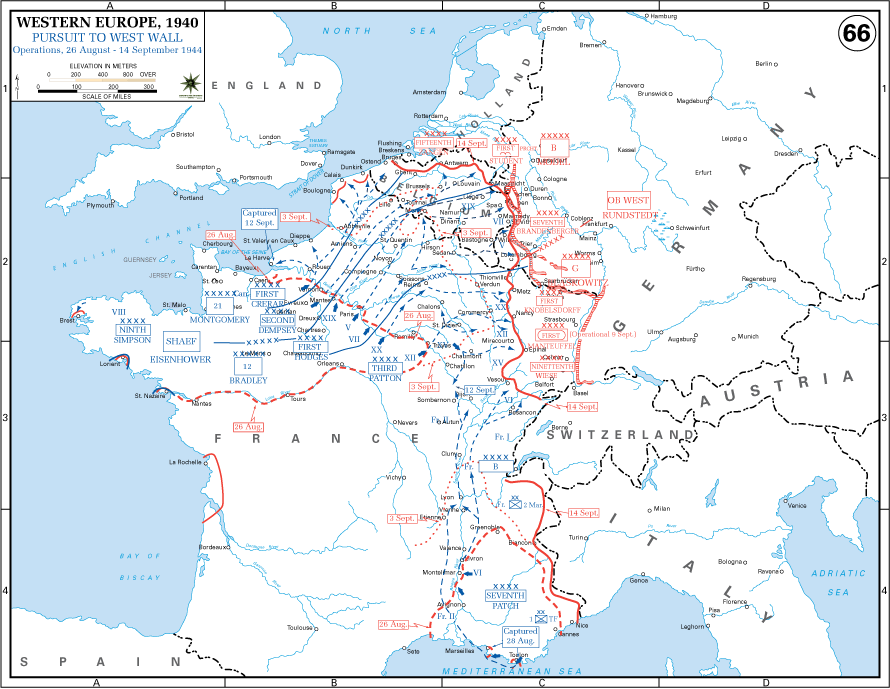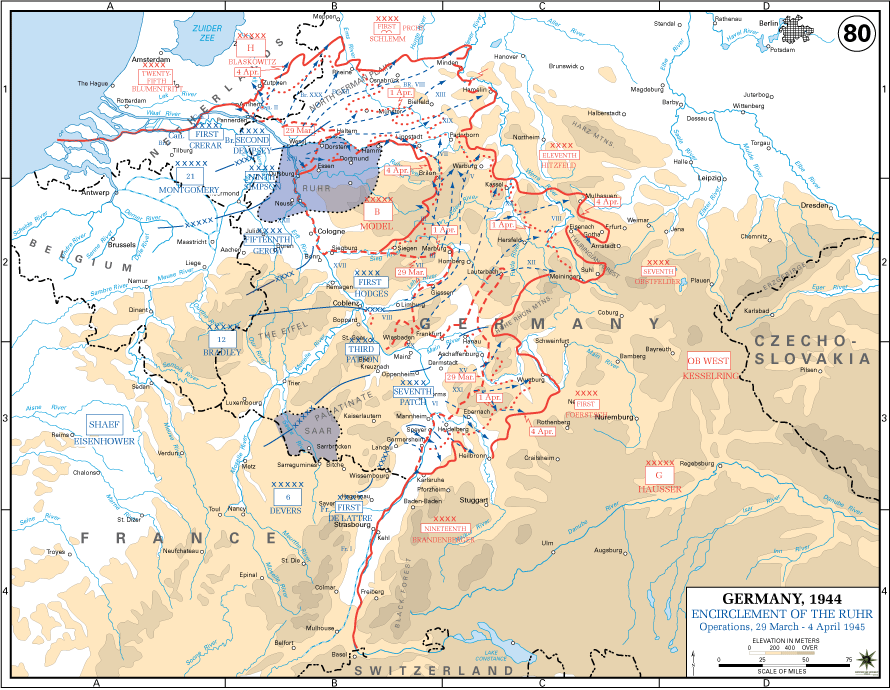Campaigns of the European Theater In World War II
D-Day & Normandy (6 Jun 44 - 24 Jul 44)
Northern France (25 Jul 44 - 14 Sep 44)
Southern France (15 Aug 44 - 14 Sep 44)
Rhineland (15 Sep 44 - 21 Mar 45)
Ardennes-Alsace (16 Dec 44 - 25 Jan 45)
Central Europe (22 Mar 45 - 11 May 45)
Divisions that Fought in the European Theater
1st Infantry division
2nd Infantry division
3rd Infantry division
4th Infantry division
5th Infantry division
8th Infantry division
9th Infantry division
26th Infantry division
28th Infantry division
29th Infantry division
30th Infantry division
35th Infantry division
36th Infantry division
42nd Infantry division
44th Infantry division
45th Infantry division
63rd Infantry division
65th Infantry division
66th Infantry division
69th Infantry division
70th Infantry division
71th Infantry division
75th Infantry division
76th Infantry division
78th Infantry division
79th Infantry division
80th Infantry division
83rd Infantry division
84th Infantry division
86th Infantry division
87th Infantry division
89th Infantry division
90th Infantry division
94th Infantry division
95th Infantry division
97th Infantry division
99th Infantry division
100th Infantry division
102nd Infantry division
103rd Infantry division
104th Infantry division
106th Infantry division
2nd Armored division
3rd Armored division
4th Armored division
5th Armored division
6th Armored division
7th Armored division
8th Armored division
9th Armored division
10th Armored division
11th Armored division
12th Armored division
13th Armored division
14th Armored division
16th Armored division
20th Armored division
13th Airborne division
17th Airborne division
82nd Airborne division
101st Airborne division
Campaign Overviews
D-Day and Normandy 6 June - 24 July 1944
Early on D-Day airborne troops landed in France to gain control of strategic areas. Aerial and naval bombardment followed. Then the invasion fleet, covered by an umbrella of aircraft, discharged Eisenhower�s assault forces. Soon the beachhead was secure, but its expansion was a slow and difficult process in the face of strong opposition. It was not until late in July that the Allies were able to break out of Normandy.
Northern France 25 July - 14 September 1944
Bombardment along a five-mile stretch of the German line enabled the Allies to break through on 25 July. While some armored forces drove southward into Brittany, others fanned out to the east and, overcoming a desperate counterattack, executed a pincers movement that trapped many Germans in a pocket at Falaise. The enemy fell back on the Siegfried Line, and by mid-September 1944 nearly all of France had been liberated. During these operations in France, while light and medium bombers and fighter-bomber aircraft of Ninth Air Force had been engaged in close support and interdictory operations, Eighth and Fifteenth Air Forces had continued their strategic bombing.
Southern France 15 August - 14 September 1944
While the Germans were retreating in Italy in the summer of 1944, the Allies diverted some of their strength in the theater to the invasion of Southern France. After preliminary bombardment, a combined seaborne-airborne force landed on the French Riviera on 15 August. Marseilles having been taken, Sevmth Army advanced up the Rhone Valley and by mid-September was in touch with Allied forces that had entered France from the north.
Rhineland 15 September 1944 - 21 March 1945
Attempting to outflank the Siegfried Line, the Allies tried an airborne attack on Holland on 17 September 1944. But the operation failed, and the enemy was able to strengthen his defensive line from Holland to Switzerland. Little progress was made on the ground, but the aerial attacks on strategic targets continued. Then, having regained the initiative after defeating a German offensive in the Ardennes in December 1944, the Allies drove through to the Rhine, establishing a bridgehead across the river at Remagen.
Ardennes-Alsace 16 December 1944 - 25 January 1945
During their offensive in the Ardennes the Germans drove into Belgium and Luxembourg, creating a great bulge in the line. For some time the weather was bad, but when it cleared the Allies could send their planes to assist their ground forces by bombing and strafing the enemy's columns, dropping paratroops and supplies, and interdicting the enemy's lines of communications. By the end of January 1945 the lost ground had been regained and the Battle of the Bulge, the last great German offensive, was over.
Central Europe 22 March - 11 May 1945
Following the Battle of the Bulge the Allies had pushed through to the Rhine. On 22 March 1945 they began their assault across the river, and by I April the Ruhr was encircled. Armored columns raced across Germany and into Austria and Czechoslovakia. On 25 April, the day American and Russian forces met on the Elbe, strategic bombing operations came to an end. Germany surrendered on 7 May 1945 and operations officially came to an end the following day, although sporadic actions continued on the European front until 11 May.
Sources: U.S. Army Center of Military History; Air Force Combat Units of World War II, Office of Air Force History; and US War Department Battles & Campaigns-World War II; United States Militart Academt Westpoint Department of History.












